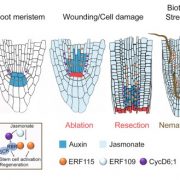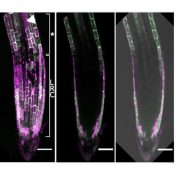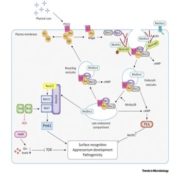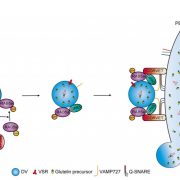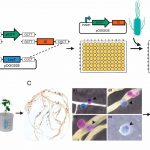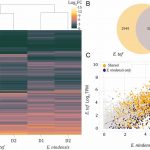Mechanical shielding in plant nuclei (Curr. Biol.)
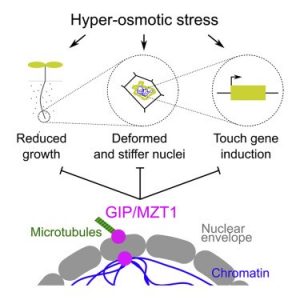 The nucleus is an organelle with tremendous shape flexibility in response to environmental cues; it has been described as the “plastic, elastic, and fantastic” organelle. The change in nuclear geometry based on mechanical stress is well documented from single cell studies in culture, but the question remains of how the nuclear geometry alters due to mechanical cues in a multicellular organism. Goswami et al. addressed this question using Arabidopsis roots under hyperosmotic stress. Hyperosmotic stress reduces root growth, leads to deformed and stiff nuclei, and eventually induces the expression of touch-related genes. Reversing the osmotic stress, either through iso-osmotic or hypo-osmotic conditions, reverses these effects. Previously, the authors showed that GIP gamma-tubulin complex-associated proteins are involved in nuclear architecture in Arabidopsis. Here, they found that in the gip1gip2 mutant, nuclei resemble those of cells experiencing hyperosmotic stress and the mutants constitutively appear to be under hyperosmotic stress. The mutant also shows enhanced growth and survival as compared to the wild-type when under hyperosmotic stress. These findings raise the question of how osmolarity affects nuclear shape, and opens the door to new opportunities to investigate drought responses in plants. (Summary by Arif Ashraf) Current Biology 10.1016/j.cub.2020.03.059
The nucleus is an organelle with tremendous shape flexibility in response to environmental cues; it has been described as the “plastic, elastic, and fantastic” organelle. The change in nuclear geometry based on mechanical stress is well documented from single cell studies in culture, but the question remains of how the nuclear geometry alters due to mechanical cues in a multicellular organism. Goswami et al. addressed this question using Arabidopsis roots under hyperosmotic stress. Hyperosmotic stress reduces root growth, leads to deformed and stiff nuclei, and eventually induces the expression of touch-related genes. Reversing the osmotic stress, either through iso-osmotic or hypo-osmotic conditions, reverses these effects. Previously, the authors showed that GIP gamma-tubulin complex-associated proteins are involved in nuclear architecture in Arabidopsis. Here, they found that in the gip1gip2 mutant, nuclei resemble those of cells experiencing hyperosmotic stress and the mutants constitutively appear to be under hyperosmotic stress. The mutant also shows enhanced growth and survival as compared to the wild-type when under hyperosmotic stress. These findings raise the question of how osmolarity affects nuclear shape, and opens the door to new opportunities to investigate drought responses in plants. (Summary by Arif Ashraf) Current Biology 10.1016/j.cub.2020.03.059
[altmetric doi=”10.1016/j.cub.2020.03.059″ details=”right” float=”right”]


